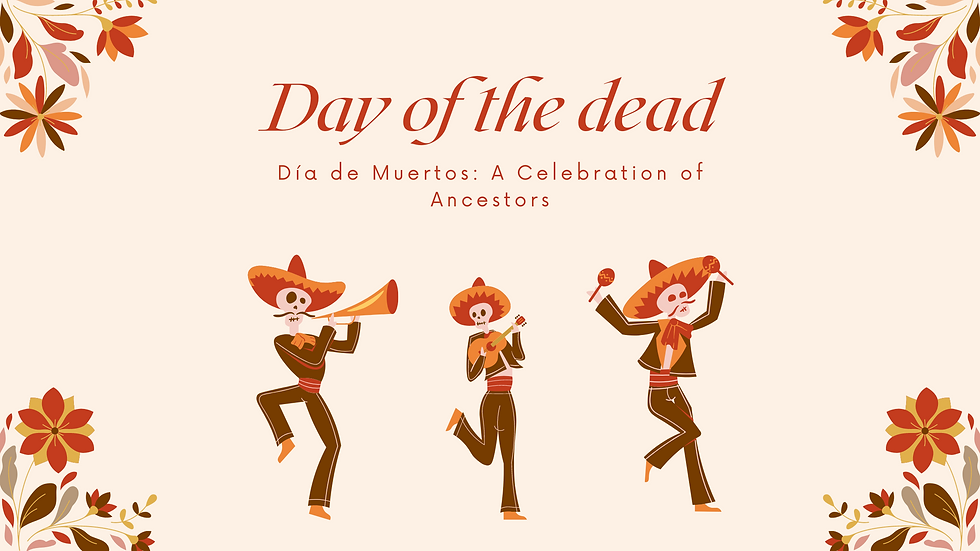Día de Muertos: A Celebration of Ancestors
- Kimberly Wilson

- Oct 26, 2024
- 4 min read
Updated: Aug 25

What Día de Muertos Teaches Us About Culture, Inclusion, and Connection.
TL;DR – Día de Muertos Is More Than a Holiday
▍ A vibrant Mexican tradition, Día de Muertos honors the lives of those who have passed.
▍ Rooted in Mesoamerican customs, it blends remembrance, food, and family.
▍ It teaches that honoring the past deepens present-day connection.
▍ At TLR Search, we value traditions like this that show how culture shapes identity and community.
Understanding Día de Muertos: A Celebration of Ancestors and Identity
If you’ve ever watched Coco, you might imagine glowing marigolds, warm food, and departed loved ones returning for a night of joy. While Disney captured the spirit of Día de Muertos, the real celebration is even more powerful. It lives on in communities across the U.S., where tradition and memory come together.
At TLR Search, we’re always looking to learn from the cultural traditions that shape who we are. Día de Muertos reminds us that remembrance isn’t somber. It’s vibrant, communal, and deeply human. Here's what we’ve learned and why it matters.
What is Día de Muertos?
Día de Muertos, or Day of the Dead, is a vibrant cultural tradition observed on November 1st and 2nd. Rooted in pre-Columbian civilizations like the Aztecs and Mayans, the holiday blends indigenous beliefs and Catholic practices to honor loved ones who have passed away.
In Mesoamerican tradition, death was not the end. It was a natural part of the life cycle. Families believed that the spirits of the departed could return during specific times of the year. They prepared gravesites with flowers and offered sugar skulls (calaveras) as symbols of remembrance. These customs laid the foundation for the modern-day Day of the Dead celebration.
Today, November 1st (Día de los Inocentes) honors deceased children, while November 2nd focuses on adults. Families welcome the spirits home with altars (ofrendas) filled with marigolds, candles, photos, and favorite foods. The celebration is not somber. It’s filled with color, warmth, and joy as people reflect on the lives and memories of those they love.
Día de Muertos: Bridging the Living and the Dead
This celebration is important because it brings together the living and the dead. It is a time to honor the past while looking toward the future. Rather than being feared, death is embraced as a natural part of life and family. Día de Muertos invites families to reconnect with those who came before and with one another, reviving traditions that may have faded across generations.
Traditional Día de Muertos Foods and Their Meaning
Food plays a central role in Día de Muertos, with many of the traditions centered in the home. One of the most iconic treats is the calavera, or sugar skull, often made from molded sugar and decorated with colorful icing. These sweet symbols represent the departed and are placed on altars as offerings. Other popular dishes include tamales, tres leches cake, pan de muerto, and seasonal favorites that reflect the tastes of those being honored. Each meal is both a tribute and a way for families to share memories through food.
Cultural Lessons from Día de Muertos
Día de Muertos carries timeless lessons that resonate across cultures. Like many celebrations around the world, it offers a chance to connect, reflect, and celebrate shared values.
Community and Family Traditions
This celebration brings people together in a spirit of unity. It’s a time when families reconnect, communities gather, and people from all backgrounds are welcomed to learn and participate.
The Importance of Rituals
Rituals are at the heart of Día de Muertos. From building ofrendas and lighting candles to sharing food and telling stories, these practices have been passed down for generations. They offer grounding, continuity, and meaning.
Honoring the Past, Connecting to the Present
Engaging in these traditions helps bridge generational and cultural gaps. Día de Muertos is more than remembrance. It’s a living expression of cultural identity and resilience.
Why Celebrations Like Día de Muertos Matter
Día de Muertos is more than a holiday; it is a reflection of how we honor memory, culture, and connection. It shows us that remembrance does not have to be quiet or mournful. It can be joyful, full of music, food, and color.
This celebration reminds us to make space for legacy in our modern lives. To share stories, cook beloved meals, and remember where we come from. These acts of honoring the past help strengthen our sense of identity and bring us closer to one another.
At its heart, Día de Muertos celebrates the richness of life through the presence of those who came before. By recognizing and respecting traditions like this one, we create a more inclusive and understanding world where heritage is honored and everyone’s story has a place.
Why This Matters to Us at TLR Search
At TLR Search, we believe that cultural understanding is essential, not just in how we live, but in how we lead and hire. Traditions like Día de Muertos remind us that everyone brings a story, a legacy, and a perspective shaped by more than a resume.
Sharing this isn’t just about honoring a holiday. It’s about celebrating identity, fostering inclusion, and helping companies build workplaces where people feel seen. When we recognize the traditions that shape people’s lives, we become better leaders, better colleagues, and better communities.
📣 Curious how cultural understanding shapes great hiring?
We help companies build inclusive, values-aligned teams because the best talent decisions come from seeing the whole person.👉 Explore TLR Search